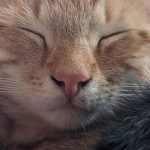As a cat lover, there’s nothing more worrisome than seeing your feline friend acting out of character. When your usually playful and energetic cat becomes lethargic and displays a dry, crusty nose, it can be a cause for concern. You’re not alone in wondering what could be causing this sudden change in behavior.
Identifying the Issue: A Dry Nose and Lethargy
Cats are notoriously low-maintenance pets, but they still require attention to their health and well-being. If you’ve noticed your cat’s usual enthusiasm waning, accompanied by a dry, cracked nose, it’s essential to investigate the underlying cause.
The Connection between Lethargy and Dry Nose
While a dry nose can be caused by various factors, such as environmental changes or medical conditions, lethargy is often an indication of a more significant issue. When your cat becomes lethargic, it may indicate a lack of energy, appetite, or even pain. By understanding the connection between these two symptoms, you’ll be better equipped to provide the necessary care and support for your feline friend.
As we dive deeper into understanding the connection between a cat’s dry nose and lethargy, it’s essential to consider potential underlying causes. One possibility is a respiratory infection or upper airway disease, such as rhinitis or sinusitis.
Respiratory Infections
Cats can contract respiratory infections through exposure to airborne pathogens, contaminated food and water, or contact with other infected animals. These infections can cause inflammation and dryness in the nasal passages, leading to a crusty nose.
When your cat is experiencing lethargy along with a dry nose, it’s possible that they’re not feeling well enough to eat or engage in their usual activities. In some cases, respiratory infections can lead to secondary complications, such as pneumonia or bronchitis, which can further exacerbate the issue.
Other Possible Causes
In addition to respiratory infections, other potential causes of a cat’s dry nose and lethargy include:
- Feline herpesvirus (FHV): This common feline viral disease can cause inflammation in the eyes, nose, and mouth.
- Feline calicivirus (FCV): Another common feline virus that can cause upper respiratory tract infections, including a dry, crusty nose.
- Environmental factors: Changes in temperature, humidity, or air quality can dry out your cat’s nasal passages and contribute to lethargy.
It’s also important to consider your cat’s age, as older cats may be more susceptible to certain health issues that can cause a dry nose and lethargy. For example, senior cats may experience age-related changes in their nasal passages or develop conditions like chronic rhinitis.
If you’re concerned about your cat’s dry nose and lethargy, it’s always best to consult with a veterinarian for a proper diagnosis and treatment plan. By understanding the underlying cause of these symptoms, you can provide the necessary care and support to help your feline friend feel better.
For more information on common health issues in cats, visit the American Animal Hospital Association (AAHA) website at https://www.aaha.org/pet_owners/common_health_issues_in_cats.aspx.
Stay tuned for our next installment, where we’ll explore the importance of proper care and treatment for cats with dry noses and lethargy.
Consult a Veterinarian
If your cat is experiencing lethargy and dry nose, consult with a veterinarian to rule out any underlying health issues.
Consult a VeterinarianIn our previous discussion, we explored the concerning symptoms of lethargy and a dry, crusty nose in cats. As you’ve learned, these signs can be indicative of a range of underlying issues, from environmental changes to medical conditions.
A Summary of Key Points
To recap, here are some key takeaways:
- A dry nose and lethargy in cats can be a cause for concern, requiring investigation into the underlying cause.
- Lethargy may indicate a lack of energy, appetite, or pain, making it essential to identify the root issue.
- The connection between these symptoms can provide valuable insights into your cat’s overall health and well-being.
Final Insights: What You Can Do
If you’ve noticed these concerning signs in your cat, don’t delay seeking veterinary care. By working with a qualified professional, you’ll be able to identify the underlying cause and develop an effective treatment plan.
A Call to Action: Prioritizing Your Cat’s Health
Remember, as a responsible cat parent, it’s your duty to prioritize your feline friend’s health and well-being. By staying vigilant for changes in behavior and seeking timely medical attention, you’ll be giving your cat the best chance at a happy, healthy life.
Don’t let lethargy and a dry nose go unchecked – take control of your cat’s health today! Consult with your veterinarian, make necessary adjustments to their care, and provide the love and attention they crave. Your cat will thank you for it.
The Average Resting Heart Rate for Teenage Girl: Ever wondered what a normal resting heart rate is for teenage girls? We’ve got you covered! Discover the average range and learn how to monitor your own heart health with our expert insights.
The Best Dog for a Single Female Living in an Apartment: Are you a single female living in an apartment looking for the paw-fect canine companion? We’ve curated a list of breeds that are perfect for city living, including intelligence, energy level, and training requirements.


